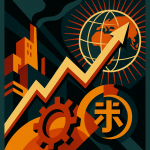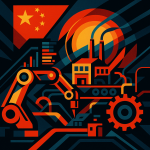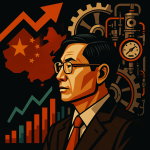Key Points
- China is exploring the fusion of stablecoins and industrial digital assets to transform manufacturing and finance.
- A high-level seminar hosted by the China Academy of Industrial Internet (CAII) (Gonglian Yuan 工联院), attended by major players like Ant Group (Mayi Jituan 蚂蚁集团) and officials from MIIT (Gongxinbu Gongye Hexinxiehui 工信部工业和信息化部), highlighted stablecoins’ potential to disrupt global monetary systems and manufacturing models through industrial asset tokenization.
- The core idea is to tokenize industrial data and assets using stablecoins to enable “Product-as-a-Service” models, allowing for real-time pricing and trading of industrial resources.
- This integration offers four key synergies: easier asset on-chaining, dramatically lower transaction costs, supercharging industrial digitization, and new tools for financial innovation.
- Real Data Assets (RDA), a specific type of Real-World Assets (RWA), are seen as the “soul of RWA” and crucial for connecting crypto with data, potentially solving financing bottlenecks for physical assets.

China is getting serious about the future of stablecoins and industrial digital assets, and it could be a game-changer for manufacturing and finance.
A high-level seminar just brought together some of the heaviest hitters in Chinese tech and government to map out this exact future.
We’re talking about a potential paradigm shift, where the digital and physical worlds of industry collide in a way that unlocks massive value.
Let’s break down what happened and why it matters for investors, founders, and tech watchers.
The High-Stakes Meeting: Who Was in the Room?
This wasn’t your average tech meetup.
The “Stablecoins and Industrial Digital Assets Seminar” was hosted by the China Academy of Industrial Internet (CAII) (Gonglian Yuan 工联院), a key institution under the government’s tech ministry.
Officials from the Ministry of Industry and Information Technology’s (MIIT) (Gongxinbu Gongye Hexinxiehui 工信部工业和信息化部) were there to provide guidance, signaling serious government interest.
And the guest list? It was a who’s who of Chinese tech, finance, and academia:
- Ant Group (Mayi Jituan 蚂蚁集团)
- Tsinghua University (Qinghua Daxue 清华大学)
- SoftBank Asia (Ruan Yinxing Yazhou 软银亚洲)
- Guosen Securities (Guoxin Zhengquan 国信证券)
- China Aerospace Science and Industry Corporation (CASIC) (Hangtian Kēgōng Jítuán 航天科工集团)
- Yujian Digital Technology (Yujian Shuke 驭鉴数科)
- Beijing Beifang (Jingbeifang 京北方)
The consensus from this powerhouse group was clear, and it boiled down to three key takeaways:
- Stablecoins are set to shake up the global monetary system.
- They can be used to completely transform manufacturing models.
- It’s time to start piloting the tokenization of industrial assets.

Find Top Talent on China's Leading Networks
- Post Across China's Job Sites from $299 / role
- Qualified Applicant Bundles
- One Central Candidate Hub
Your First Job Post Use Checkout Code 'Fresh20'

So, How Do Stablecoins and Industrial Assets Actually Work Together?
Here’s the core idea.
Think about all the data generated by high-end industrial equipment—real-time operating stats, computing power, supply chain info.
Right now, that data is valuable, but it’s hard to price and trade efficiently.
By using stablecoins—cryptocurrencies pegged to a stable asset like the dollar—you can put these industrial data resources on a blockchain.
This process, called tokenization, gives the data a clear owner, a verifiable price, and a way to be circulated or traded instantly and cheaply.
The ultimate goal? To shift the entire manufacturing industry from just selling a physical product to selling “Product-as-a-Service.”
Imagine leasing a piece of factory equipment and paying for its usage in real-time with stablecoins, or selling the unused computing power from your factory’s servers on an open market.
This is the high-value-added future they’re aiming for.

ExpatInvest China
Grow Your RMB in China:
- Invest Your RMB Locally
- Buy & Sell Online in CN¥
- No Lock-In Periods
- English Service & Data
- Start with Only ¥1,000

A Quick Primer: What Are Industrial Digital Assets?
When we talk about “industrial digital assets,” we’re referring to valuable, tradable digital items from the industrial world.
They mainly fall into four buckets:
- Data Assets: This is the raw gold. Think equipment operating parameters, production process data, and supply chain logistics information.
- Digital Twin Assets: These are virtual models of physical things—like a factory or a production line. Engineers use them for simulations and optimization before making real-world changes.
- Smart Assets: Think intelligent algorithms or equipment control units that enable things like automated predictive maintenance.
- Blockchain Assets: These are industrial assets that are already “on-chain.” Examples include tokens representing equipment computing power or digital certificates for carbon emission rights.

Resume Captain
Your AI Career Toolkit:
- AI Resume Optimization
- Custom Cover Letters
- LinkedIn Profile Boost
- Interview Question Prep
- Salary Negotiation Agent

The 4 Key Synergies Unlocking New Value
The combination of stablecoins and these assets isn’t just theoretical. It creates tangible benefits that could solve some of the industry’s biggest headaches.
1. Easy Asset On-chaining and Rights Confirmation
By using blockchain technology, you can tokenize an asset like the real-time operating data from a jet engine. This confirms ownership and allows it to be traded using stablecoins, all with a clear, auditable trail.
2. Dramatically Lower Transaction Costs
Stablecoins offer near-instant, on-chain settlement with very low fees. For something like cross-border trade, this is huge. It can replace slow, expensive traditional settlement methods and slash accounting periods from days to seconds.
3. Supercharging Industrial Digitization
This combo is the engine for the “product-as-a-service” model. It allows for new business models like digitizing equipment leasing or sharing a factory’s computing power, all settled seamlessly with stablecoins.
4. New Tools for Financial Innovation
Industrial digital assets can be used as collateral for loans, all managed via smart contracts. You could even create token incentive models to optimize revenue sharing. For example, a company could use its tokenized data assets as collateral to get a supply chain finance loan.

Enter RWA & RDA: The Link Between the Real and Digital Worlds
You’ve probably been hearing a lot about Real-World Assets (RWA) lately. It’s one of the hottest trends in crypto and finance.
RWA is simply the process of taking a physical asset—like real estate, art, or in this case, industrial equipment—and turning it into a digital token on a blockchain.
A specific and highly relevant type of RWA is Real Data Assets (RDA).
As the name implies, RDA involves tokenizing data assets.
This aligns perfectly with the goal of bringing industrial data on-chain.
According to Guotou Securities (Guotou Zhengquan 国投证券), RDA is the “soul of RWA” and the bridge connecting crypto with data.
This is a big deal because it could solve huge financing bottlenecks for physical assets by opening up new funding channels like credit financing, securitization, and even global fundraising through tokenization.

Investor Radar: Key Companies in the Stablecoin & RWA Space
Naturally, the financial world is taking notice.
China Merchants Securities (Zhaoshang Zhengquan 招商证券) put out a research report suggesting that as regulations advance, the integration of stablecoins and RWA with traditional finance could kick off a “global financial innovation supercycle.”
They highlighted several key companies to watch:
Primary Focus:
- Hundsun Technologies (Hengsheng Dianzi 恒生电子)
- GDI Software (Dingdian Ruanjian 顶点软件)
- Yuxin Technology (Yuxin Keji 宇信科技)
- Tianyang Technology (Tianyang Keji 天阳科技)
- Newland Payment Technology (Xin Dalu 新大陆)
- Newcapec (Xin Guodu 新国都)
- Longshine Technology (Longxin Jituan 朗新集团)
- Lianlian Digital (Lianlian Shuzi 连连数字)
- ZhongAn Online (Zhong An Zaixian 众安在线)
- OSL Group, Circle, Coinbase
Additional Recommendations:
- Sifang Jingchuang (Sifang Jingchuang 四方精创)
- Beijing Beifang (Jingbeifang 京北方)
- GoldCard Electromechanical (Jinzheng Gufen 金证股份)
- Lakala (Lakala 拉卡拉)
- GCL New Energy (Xiexin Nengke 协鑫能科)
The report also noted that RDA is set to accelerate the marketization of data, creating opportunities for infrastructure providers, data resource owners, and service providers.
Companies to watch in the RDA space include:
- Taiji Computer Corporation (Taiji Gufen 太极股份)
- Yihua Healthcare (Yihua Lu 易华录)
- Shennan Circuits (Shensangda 深桑达)
- YunSheng Zhilian (Yunsai Zhilian 云赛智联)
- StarRocks
- Tongxingbao (Tongxingbao 通行宝)
- Grandsun Technology (Shengshi Keji 盛视科技)
- Guoxin Health (Guoxin Jiankang 国新健康)
- Shanghai Steel Union (Shanghai Ganglian 上海钢联)
- Jiuyuan Yinhai (Jiuyuan Yinhai 久远银海)
- Bos Software (Bosi Ruanjian 博思软件)
- Zhongke Jiangnan (Zhongke Jiangnan 中科江南)
- Desheng Technology (Desheng Keji 德生科技)
- Data Assets: Raw data from industrial operations (e.g., equipment parameters, production data, supply chain information).
- Digital Twin Assets: Virtual models of physical industrial entities used for simulation and optimization.
- Smart Assets: Intelligent algorithms or control units enabling advanced functionalities like predictive maintenance.
- Blockchain Assets: Industrial assets already tokenized on a blockchain (e.g., tokens for computing power, digital carbon rights).

The Bottom Line
This isn’t just a theoretical exercise.
When you have the MIIT, Ant Group, and SoftBank in the same room, it’s a clear signal that the wheels are in motion.
The fusion of stablecoins and industrial digital assets is an active, strategic exploration in China that has the potential to redefine manufacturing, supply chains, and finance on a global scale.





